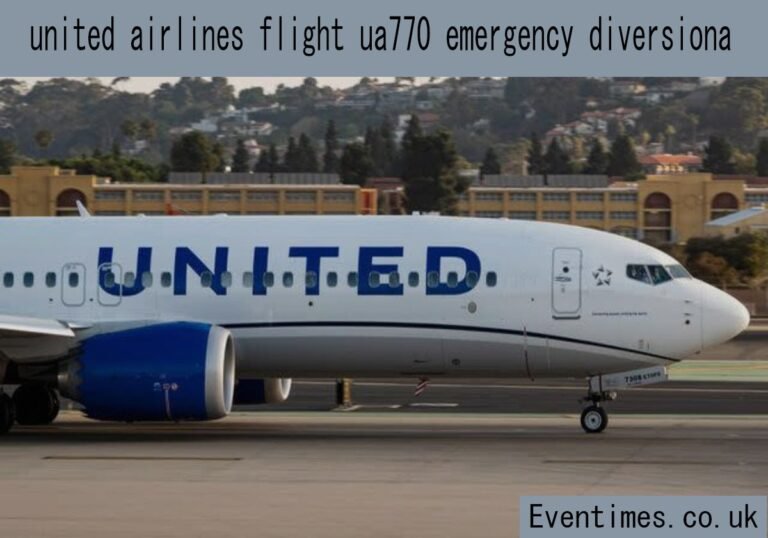Contents
Introduction to the Incident
On July 21, 2025, United Airlines Flight UA770 Emergency Diversion took off from Barcelona to Chicago. What started as a routine flight soon escalated into a serious situation. The Boeing 787-9 Dreamliner was in the air when the crew found a pressurization problem. This issue posed a significant threat to the safety of everyone on board. The flight had 257 passengers and 12 crew members. They rerouted the flight to London Heathrow, which is a busy airport. Emergency teams were ready to handle the situation upon arrival.
This incident demonstrates why preparedness in aviation is crucial. It shows how trained crews, clear communication, and advanced technology work together. They help keep passengers safe in unexpected situations.
Timeline of Events During the Flight
The flight took off from Barcelona El Prat Airport. It was flying at 37,000 feet over the Atlantic Ocean when the issue arose. About 90 minutes into the flight, the crew received an alert. It warned of a pressurization failure. This issue could have a significant effect on the safety of everyone on board.
The captain declared an emergency by using the 7700 code without delay. This code alerts air traffic control to a serious in-flight issue. The crew sprang into action. Trainers prepared them for emergencies. They began their descent and reached out to air traffic control. They wanted to know the nearest airport.
The plane descended in a steep glide. At about 4:55 PM BST, Flight UA770 made a secure landing on Runway 27R at Heathrow Airport. Emergency vehicles were ready and waiting.
What led to the emergency diversion?
The primary cause of the emergency was a pressurization problem within the plane. Cabin pressurization issues can pose serious health risks for passengers. For example, hypoxia occurs when the body lacks oxygen. If not addressed, these problems can become dangerous.
Upon detecting the pressurization issue, the crew immediately followed established emergency procedures. They realized they had to divert the plane to an airport capable of handling emergencies. They picked London Heathrow as the diversion spot. It has excellent emergency facilities.
Diverting was key. Any delay could have led to serious consequences. The crew assessed the situation with urgency and took immediate action. This kept all 257 passengers and 12 crew members safe.
How did the crew and passengers respond?
The crew noticed the pressurization problem and immediately began emergency protocols. During the event, the flight attendants helped keep the cabin calm. They reassured passengers. They made sure everyone followed safety instructions. They also gave updates as the situation changed.
For the passengers, the news of an emergency created some anxiety. But, the professionalism and calm demeanor of the crew helped prevent panic. The staff updated the passengers on the actions they were taking. This built trust in the flight crew’s ability to manage the situation.
When we landed at Heathrow, the tension melted away. Passengers clapped, happy to be safe. The crew and passengers worked together. This teamwork made the emergency landing smooth and uneventful.
Safety Procedures and Protocols Implemented
The crew saw the emergency and followed the safety steps for pressurization issues. The emergency declaration (code 7700) warned air traffic control. It allowed the flight crew and ground services to coordinate right away.
Heathrow alerted emergency teams. Emergency vehicles were ready at the runway to assist when needed. When we landed, the plane received priority. A team took the passengers off the plane in a swift manner. Ground teams then checked the plane for security.
The crew’s safety procedures were key to a safe landing, even during the emergency. The clear communication between the crew and air traffic control helped a lot. Heathrow was ready, which ensured that the emergency diversion proceeded without complications.
The Aftermath of the Incident
After the emergency landing, a bus took passengers to the terminal. There, United Airlines staff met them. The airline assisted passengers with rebooking on other flights on time. They also gave hotel vouchers to those affected by the delay.
The authorities grounded the plane for inspection. They wanted to find out the cause of the pressurization issue. Preliminary findings pointed to a malfunction within the plane’s pressurization system. The investigation found the plane safe for service. Everyone remained unharmed.
The incident caused a delay, but United Airlines took care of the passengers. They adjusted travel plans with the greatest efficiency they could muster.
Expert Insights on Emergency Diversions
Aviation experts highlight how crucial emergency diversions are for safety in critical situations. UA770 faced necessary diversions. They help prevent technical failures from worsening. This keeps passengers safe.
A key reason for this successful emergency diversion was the flight crew’s training. Pilots today practice drills and simulations often. This training helps them handle different in-flight emergencies. This training helps them make quick decisions and take decisive actions under pressure. This ensures passenger safety.
Another key factor in this incident was the role of technology. The Boeing 787-9 Dreamliner has real-time monitoring systems. These systems send key aircraft data to the airline’s operations center. Sharing data quickly helps air traffic controllers and ground services prepare for emergencies. This way, they can make quick decisions and respond effectively.
Conclusion: Key Takeaways from the UA 770 Emergency Diversion
United Airlines Flight UA770 Emergency Diversion. This incident highlights how crucial crew training and technology are for passenger safety. Being prepared is key.
This incident reminds passengers that safety procedures help manage emergencies well. The crew’s skills and airports like Heathrow show that the aviation industry is ready for in-flight emergencies.
United Airlines’ response to Flight UA770 shows how vital crisis management is for keeping passengers safe. Well-prepared crews make a big difference, even in stressful times.
